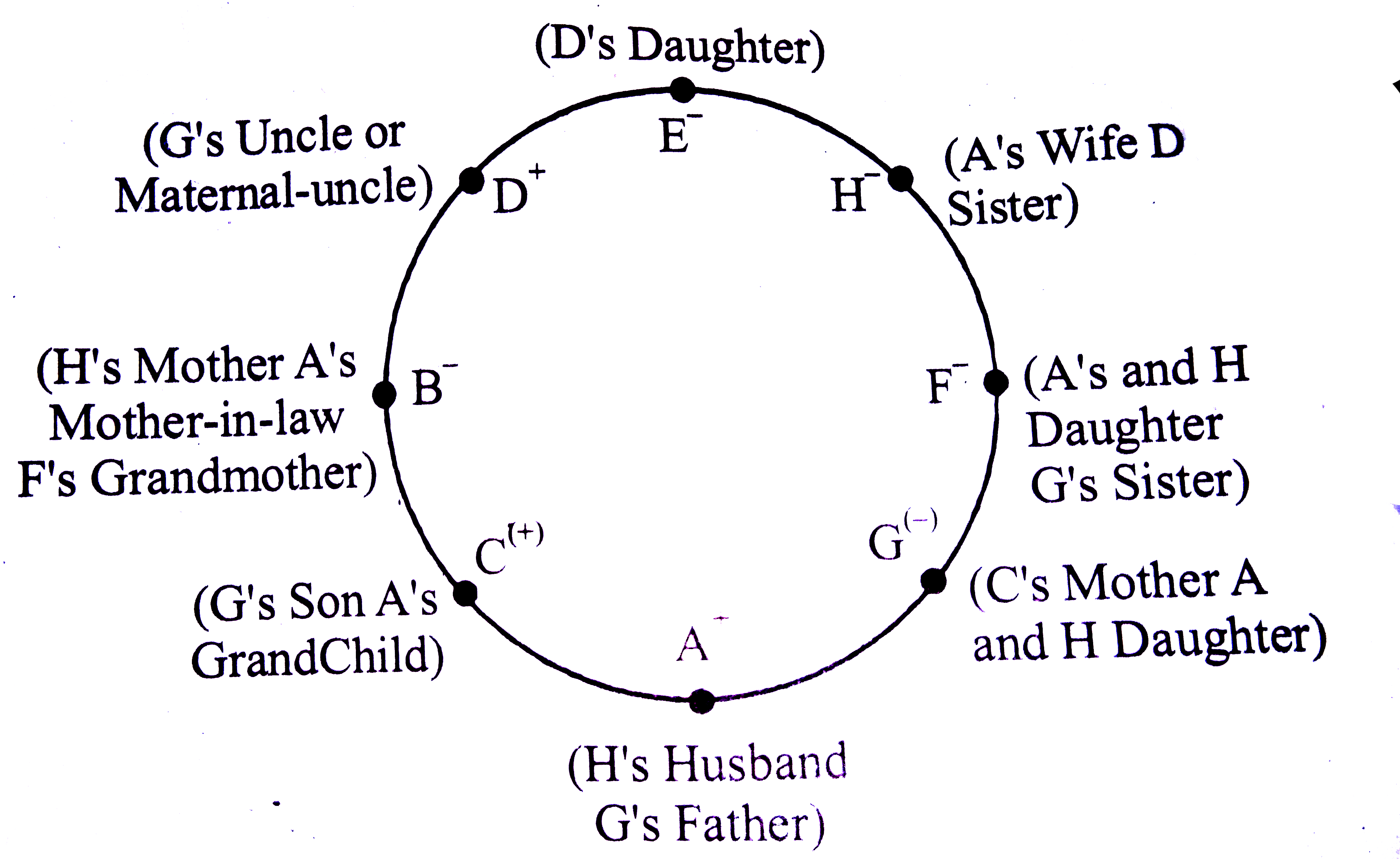(i) A, B, C, D, E, F, G and Hare sitting around a circle facing the centre but not necessarily in the same order.
(ii) B sits second to left of H's husband. No female is an immediate neighbour of B.
(iii) D's daughter sits second to right of F, F is the sister of G. F is not an immediate neighbour of H's husband.
(iv) Only one person sits between A and F. A is the father of G H's brother D sits to the immediate left of H's mother. Only one person sits between H's mother and E.
(v) Only one person sits between Hand G. G is the mother of C. G is not an immediate neighbour of E.
Which of the following is true with respect to the given seating arrangement ?
C is the cousin of E
H and H's husband are immediate neighbours of each other
No female is an immediate neighbour of C
B is the mother of H
The correct Answer is:D

B is the mother of H which is true with respect to the given sitting arrangement
Topper's Solved these Questions
Similar Questions
Correct figure in the following

View SolutionWhat should next in the following letter series based on English alphabet ?
CEA IKG OQM ?
View Solutionचुम्बकीय क्षेत्र (B ) में वेग (v ) से गतिमान आवेश q के एक कण पर लगने वाला बल (F ) है-
View Solutionएक छात्र को A,B,C या D ग्रेड मिलने की सम्भावना है। प्रायिकता ज्ञात कीजिये कि कम से कम B ग्रेड प्राप्त कर सके, जबकि A ग्रेड प्राप्त करने की प्रायिकता : 20,B ग्रेड प्राप् करने की प्रायिकता 40,C ग्रेड प्राप्त करने की प्रायिकता- 30,D ग्रेड प्राप्त करने की प्रायिकता 10 है।
View Solutionरासायनिक अभिक्रियाओं के आधार पर निम्नलिखित धातुओं की विधुत - रासायनिक श्रेणी का निर्माण करो ।
(i) A+H2SO4→ASO4+H2
(ii) C+ACl2→CCl2+A
(iii) C+ECl2→ अभिक्रिया नहीं होती
(iv) D+2BCl→DCl2+2B
(v) D+H2SO4→ अभिक्रिया नहीं होती |
View Solutionनिम्नलिखित समीकरणों के अनुसार धातु A,B,C,D व H2 की विधुत - रासायनिक श्रेणी का निर्माण करो ।
(i) 2A+2HCl→2ACl+H2
(ii) B+2HCl→BCl2+H2
(iii) 2A+BCl2→2ACl+B
(iv) D+CCl2→DCl2+C
(v) D+HCl→ कोई अभिक्रिया नहीं
View Solutionपांच तत्व A, B, C, D व E के E∘ क्रमशः −1.36,+0.32,+1.36,−0.42 तथा −2.2.6 है उनको बढ़ती सक्रियता के क्रम में लिखो ।
View Solutionनीचे कुछ अभिक्रियाएँ दी गयी है-
(a) ACl2+B→BCl2+A
(b) B+DCl→ कोई अभिक्रिया नहीं
(c) C+2DCl→2D+CCl2
(d) C+ECl2→ कोई अभिक्रिया नहीं
(e) H2+ECl2→2HCl+E
(f) H2+FCl2→ कोई अभिक्रिया नहीं
उपरोक्त दिए तत्वों (A से F) को रासायनिक सक्रियता के घटते क्रम में व्यवस्थित करो ।
View Solutionनिम्नलिखित कथनों पर विचार करें :
कथन I : माना कि ddx{f(x)+c}=F(x) तब ∫F(x)dx=f(x)+c
कथन II : समाकलन, अवकलन का प्रतिलोम प्रक्रम है | इन कथनो में :
View Solution∫ex{f(x)+f'(x)}dx को खंडश: समाकलन के प्रयोग से ज्ञात कर सकते है |
∫f(x)dx+∫exf'(x)dx=∫exf(x)dx+exf(x)−∫exf(x)dx+c
=exf(x)+c
तथा ∫eax{f(x)+f'(x)a}dx eaxf(x)a+c
इसलिए सही उत्तर चुने :
∫ex(tan−1x+11+x2)dx=
View Solution∫ex{f(x)+f'(x)}dx को खंडश: समाकलन के प्रयोग से ज्ञात कर सकते है |
∫f(x)dx+∫exf'(x)dx=∫exf(x)dx+exf(x)−∫exf(x)dx+c
=exf(x)+c
तथा ∫eax{f(x)+f'(x)a}dx eaxf(x)a+c
इसलिए सही उत्तर चुने :
e^(x)((1+sin x)/(1+cos x))dx=
View Solutionपहले बहुपद से दूसरे बहुपद को भाग करके, जॉंच कीजिए कि क्या प्रथम बहुपद द्वितीय बहुपद का एक गुणनखण्ड है :
g(t)=t2−3,f(t)=2t4+3t3−2t2−9t−12
View Solutionपहले बहुपद से दूसरे बहुपद को भाग करके, जॉंच कीजिए कि क्या प्रथम बहुपद द्वितीय बहुपद का एक गुणनखण्ड है :
g(x)=x3−3x+1,f(x)=x5−4x3+x2+3x+1
View Solutionपहले बहुपद से दूसरे बहुपद को भाग करके, जॉंच कीजिए कि क्या प्रथम बहुपद द्वितीय बहुपद का एक गुणनखण्ड है :
g(x)=2x2−x+3,f(x)=6x5−x4+4x3−5x2−x−15
View Solutionबहुपद f(x)=ax2+bx+c का आलेखः चित्र में दर्शाया गया है | 'a' तथा b2−4ac के चिन्ह लिखिए |

View Solutionबहुपद f(x)=ax2+bx+c का आलेख चित्र में दर्शाया गया है | b2−4ac का मान तथा बहुपद f(x) के वास्तविक शुन्यकों की संख्या लिखिए |

View Solution
